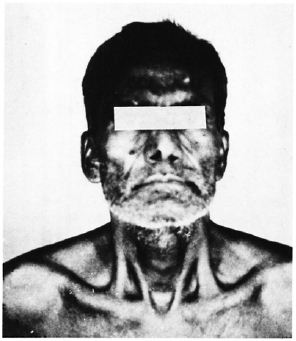- Volume 59 , Number 3
- Page: 479–80
Trigeminal trophic syndrome in hansen's disease
This department is for the publication of informal communications that are of interest because they are informative and stimulating, and for the discussion of controversial matters. The mandate of this Journal is to disseminate information relating to leprosy in particular and also other mycobacterial diseases. Dissident comment or interpretation on published research is of course valid, but personality attacks on individuals would seem unnecessary. Political comments, valid or not, also are unwelcome. They might result in interference with the distribution of the Journal and thus interfere with its prime purpose.
To the Editor:
A 60-year-old man, a known case of mid-borderline Hansen's disease, was seen for facial nerve palsy. There was no history of transient ischemic attack, convulsion, dimness of vision, or herpes zoster. On examination, he had features of Hansen's disease- left-sided facial palsy of lower motor neuron type and anesthesia over the trigeminal area, loss of corneal reflex and destruction of the ala nasi on the right side (The Figure). A clinical diagnosis of Hansen's disease with trigeminal trophic syndrome was made. A neurologist's opinion was sought to exclude other causes of facial and trigeminal nerve involvement which ruled out the possibility of any organic cause in the brain attributable to the nerve damage (both trigeminal and facial). A slit-skin smear for acid-fast bacilli was negative. The patient is being treated with the multidrug regimen for multibacillary Hansen's disease and is being followed up.
The trigeminal trophic syndrome is an uncommon clinical entity presenting with trophic ulcer(s) over the already anesthetic or paraesthetic area of the trigeminal nerve distribution beginning in the ala nasi. It results from destruction of the fibers that carry pain and temperature senses, and is due to various causes such as disease, injury, or surgery (1).
The lesions producing such destruction may be of central or peripheral origin (3). The central connection of the trigeminal nerve may be affected by tumors, syringobulbia, multiple sclerosis, or occlusion of the posterior cerebellar artery. The peripheral causes encountered are tabes dorsalis, granulomatous meningitis, tumors of the nerve, pressure from without on the nerve, fracture of the base of the skull, and alcohol injection into the gasserian ganglion. The dermatological diseases giving rise to such changes are herpes zoster and Hansen's disease.
As a result of trauma to the anesthetic or paraesthetic area, a crusted ulcer begins usually in the ala nasi of the affected side. If further trauma is not prevented, the ulcer extends to even destroy the nasal cartilage.

The Figure. Destruction is seen of the right ala nasi with tropic ulcerations on the same side; note hypopigmcnted patch on left shoulder.
The ulceration may spread to the adjacent anesthetic areas as well, and these ulcers easily may be mistaken for basal-cell epitheliomas because of the site and crusting. Due to their bizarre clinical appearance, they may even simulate dermatitis artifacts. Bleeding, scarring, and deformity are the troublesome complications of such ulcers. In addition to cutaneous ulcers, corneal anesthesia may also be noted (particularly in patients whose trigeminal trophic syndrome is secondary to Hansen's disease).
Although trophic changes in the trigeminal area have been reported to result from various causes such as the injection of alcohol into the gasserian ganglion (2), their occurrence secondary to Hansen's disease, as in our case, is very rare. To the best of our knowledge, no textbook on Hansen's disease includes trigeminal trophic syndrome as one of the trophic complications of leprosy.
- Jayakar Thomas, M.D., Ph.D.
Assistant Professor
-S. Parimalam, M.B.B.S., D.D.
Postgraduate Student
- G. Thamarai Selvi, M.B.B.S.
Postgraduate Student
- S. M. Augustine, M.D.
Additional Professor
- T. C. Muthuswami, M.D.
Professor
Department of Dermatologyand Leprosy
Government General Hospital
Madras 600003, India
REFERENCES
1. Cunliffe, W. J. and Savin, j. A. The skin and Ihc nervous system. In: Textbook of Dermatology. 4th cd. Rook, A., ed. Oxford: Oxford University Press, 1986, pp. 2229-2255.
2. Howell, J. IJ. Neurotrophic changes in the trigeminal territory. Disturbances after operation for trigeminal neuralgia. Arch. Dermatol. 86(1962)442-449.
3. Walton, J. Cranial nerves and special senses. In: Brain's Diseases of the Nervous System. 9 th cd. Walton, J. N., cd. Oxford: Oxford University Press, 1985, pp. 89-134.